HFSE-REE Transfer Mechanisms During Metasomatism of a Late Miocene Peraluminous Granite Intruding a Carbonate Host (Campiglia Marittima, Tuscany)
Abstract
1. Introduction
2. Geological Petrographic Background
3. Methods
4. Results—Microtextures and Mineral Chemistry
4.1. Magmatic Minerals
4.1.1. Feldspar Group
4.1.2. Phyllosilicates Group
4.1.3. Accessory Minerals
4.2. Metasomatic Minerals
4.2.1. Feldspar Group
4.2.2. Phyllosilicates Group
4.2.3. Titanium Minerals
4.2.4. Calc-Silicate Minerals (Pyroxene, Vesuvianite, Garnet, Epidote Group Minerals)
4.2.5. HFSE-REE–Rich Minerals
4.2.6. Fluorite
4.2.7. Sulfides
5. Discussion—Element Transfer Mechanisms During Metasomatic Processes
5.1. Potassic-Calcic Metasomatism
5.2. Acidic Metasomatism—Declining Ca-Activity and Increasing F-Activity
5.3. Footprints of Fluid-Rock Element Transfer in Mineral Zoning
5.3.1. Links Between Concurrently Growing Minerals During Metasomatism
5.3.2. Links Between REE-HFSE Mobilization and Fluorine Activity
6. Nature and Source of Metasomatic Fluids at Campiglia
7. Summary and Conclusions
Supplementary Materials
Author Contributions
Funding
Acknowledgments
Conflicts of Interest
References
- Paoli, G.; Dini, A.; Rocchi, S. Footprints of element mobility during metasomatism linked to a late Miocene peraluminous granite intruding a carbonate host (Campiglia Marittima, Tuscany). Int. J. Earth Sci. 2019, 108, 1617–1641. [Google Scholar] [CrossRef]
- Pirajno, F. Hydrothermal Processes and Mineral Systems; Springer: Berlin, Germany, 2009. [Google Scholar]
- Pirajno, F. Effects of metasomatism on mineral systems and their host rocks: Alkali metasomatism, skarns, greisens, tourmalinites, rodingites, black-wall alteration and listvenites. In Metasomatism and the Chemical Transformation of Rock: The Role of Fluids in Terrestrial and Extraterrestrial Processes; Springer: Berlin/Heidelberg, Germany, 2013; pp. 203–251. [Google Scholar]
- Harlov, D.E.; Austrheim, H. Metasomatism and chemical transformation of Rock: Rock-mineral-fluid interaction in terrestrial and extraterrestrial environments. In Metasomatism and the Chemical Transformation of Rock. Lecture Notes in Earth System Sciences; Springer: Berlin/Heidelberg, Germany, 2013; pp. 1–16. [Google Scholar]
- Mathieu, L. Quantifying hydrothermal alteration: A review of methods. Geosciences 2018, 8, 245. [Google Scholar] [CrossRef]
- Putnis, A.; Austrheim, H. Fluid-induced processes: Metasomatism and metamorphism. Geofluids 2010, 10, 254–269. [Google Scholar]
- Jamtveit, B.; Wogelius, R.A.; Fraser, D.G. Zonation patterns of skarn garnets—Records of hydrothermal system evolution. Geology 1993, 21, 113–116. [Google Scholar] [CrossRef]
- Taghipour, B.; Moore, F.; Mackizadeh, M.A.; Taghipour, S. Hydrothermal garnet in porphyry copper related skarn deposits, Ali-Abad, Yazd Province, Iran. IJST 2013, A1, 11–22. [Google Scholar]
- Jiang, S.Y.; Wang, R.C.; Xu, X.S.; Zhao, K. Mobility of high field strength elements (HFSE) in magmatic-, metamorphic-, and submarine-hydrothermal systems. Phys. Chem. Earth Parts A B C 2010, 30, 1020–1029. [Google Scholar] [CrossRef]
- Gieré, R. Hydrothermal mobility of Ti, Zr and REE: Examples from the Bergell and Adamello contact aureoles (Italy). Terra Nova 1990, 2, 60–67. [Google Scholar] [CrossRef]
- Gysi, A.P.; William-Jones, A.E.; Collins, P. Lithogeochemical vectors for hydrothermal processes in the Strange Lake peralkaline granitic REE-Zr-Nb deposit. Soc. Econ. Geol. 2016, 111, 1241–1276. [Google Scholar] [CrossRef]
- Pinarelli, L.; Poli, G.; Santo, A. Geochemical characterization of recent volcanism from the Tuscan Magmatic Province (Central Italy): The Roccastrada and San Vincenzo centers. Period. Miner. 1989, 58, 67–96. [Google Scholar]
- Leoni, L.; Tamponi, M. Thermometamorphism in the Campiglia Marittima aureole (Tuscany, Italy). J. Miner. Geochem. 1991, 4, 145–157. [Google Scholar]
- Paoli, G.; Rocchi, S.; Dini, A.; Vezzoni, S.; Schaltegger, U.; Ovtcharova, M. The Plutonic-Subvolcanic-Volcanic Connection in the Long-Lived Campiglia Marittima Igneous System (Tucany, Italy): A Zircon CA-ID-TIMS Dating Study; SIMP-SGI-SOGEI-AIV: Pisa, Italy, 2017; p. 387. [Google Scholar]
- Paoli, G. Petrogeochemical and geochronological framework of element mobility during magmatic-metasomatic processes (Campiglia Marittima, Tuscany). Plinius 2018, 44, 67–71. [Google Scholar]
- Fulignati, P. Hydrothermal fluid evolution in the Botro ai Marmi quartz-monzonitic intrusion, Campiglia Marittima, Tuscany, Italy. Evidence from a fluid-inclusion investigation. Miner. Mag. 2018, 82, 1169–1185. [Google Scholar] [CrossRef]
- Borsi, S.; Ferrara, G.; Tongiorgi, E. Determinazione con il metodo K/Ar delle età delle rocce magmatiche della Toscana. Boll. Soc. Geol. Ital. 1987, 86, 403–411. [Google Scholar]
- Vezzoni, S.; Dini, A.; Rocchi, S. Reverse telescoping in a distal skarn system (Campiglia Marittima, Italy). Ore Geol. Rev. 2016, 77, 176–193. [Google Scholar] [CrossRef]
- Feldstein, S.N.; Halliday, A.N.; Davies, G.R.; Hall, C.M. Isotope and chemical micro-sampling: Constrains on the history of an S-type rhyolite, San Vincenzo, Tuscany, Italy. Geochim. Cosmochim. Acta 1994, 58, 943–958. [Google Scholar] [CrossRef]
- Whitney, D.L.; Evans, B.W. Abbreviations for names of rock-forming minerals. Am. Mineralog. 2010, 95, 185–187. [Google Scholar] [CrossRef]
- Petrelli, M.; Laeger, K.; Perugini, D. High spatial resolution trace element determination of geological samples by laser ablation quadrupole plasma mass spectrometry: Implications for glass analysis in volcanic products. Geosci. J. 2016, 20, 851–863. [Google Scholar] [CrossRef]
- Abdel-Rahman, A.F.M. Nature of biotites from alkaline, calc-alkaline and peraluminous magma. J. Pet. 1994, 35, 525–541. [Google Scholar] [CrossRef]
- Deer, W.A.; Howie, R.A.; Zussman, J. An Introduction to the Rock-Forming Minerals; Prentice Hall: New York, NY, USA, 1992. [Google Scholar]
- Farina, F.; Dini, A.; Innocenti, F.; Rocchi, S.; Westerman, D.S. Rapid incremental assembly of the Monte Capanne pluton (Elba Island, Tuscany) by downward stacking of magma sheets. Geol. Soc. Am. Bull. 2010, 122, 1463–1479. [Google Scholar] [CrossRef]
- Sun, S.S.; McDonough, W.F. Chemical and isotopic systematics of oceanic basalts: Implications for mantle composition and processes. In Magmatism in the Ocean Basins. Geol. Soc. Lond. 2010, 42, 315–345. [Google Scholar]
- Jochum, K.P.; Stolz, A.J.; Mcoirst, G. Niobium and tantalum in carbonaceous chondrites: Constraints on the solar system and primitive mantle niobium/tantalum, zirconium/niobium, and niobium/uranium ratio. Meteorit. Planet. Sci. 2000, 35, 229–235. [Google Scholar] [CrossRef]
- Groat, L.A.; Hawthorne, F.C.; Ercit, T.S. The chemistry of vesuvianite. Can. Miner. 1992, 30, 19–48. [Google Scholar]
- Gaspar, M.; Knaack, C.; Meinert, L.; Moretti, R. REE in skarn Systems: A LA-ICP-MS study of garnets from the Crown Jewel gold deposit. Geochim. Cosmochim. Acta 2008, 72, 185–205. [Google Scholar] [CrossRef]
- Einaudi, M.T.; Meinert, L.D.; Newberry, R.J. Skarn deposits. Econ. Geol. 1985, 75, 317–391. [Google Scholar]
- Nakano, T.; Takahara, H.; Norimasa, N. Intracrystalline distribution of major elements in zoned garnet from skarn in the Chichibu mine, central Japan; illustration by color-coded maps. Can. Miner. 1989, 27, 499–507. [Google Scholar]
- Meinert, L.D. Application of skarn deposit zonation models to mineral exploration. Explor. Miner. Geol. 1997, 6, 185–208. [Google Scholar]
- Petrík, I.; Broska, I.; Lipka, J.; Siman, P. Granitoid allanite-(Ce): Substitution relations, redox conditions and REE distributions (on an example of I-type granitoids, Western Carpathians, Slovakia). Geol. Carpathica 1995, 46, 79–94. [Google Scholar]
- Vlach, S. Structural and compositional variations of hydrothermal epidote-group minerals from a peralkaline granite, Corupá pluton, Graciosa Province, south Brazil. Acad. Bras. Cienc. 2012, 84, 407–425. [Google Scholar] [CrossRef]
- Shore, M.; Fowler, A.D. Oscillatory zoning in minerals: A common phenomenon. Can. Miner. 1996, 34, 1111–1126. [Google Scholar]
- Harlov, D.E.; Marschall, H.R. Mechanisms of metasomatic reactions. Miner. Pet. 2009, 95, 159–161. [Google Scholar] [CrossRef][Green Version]
- Markl, G.; Piazolo, S. Stability of high-Al titanite from low-pressure calcsilicates in light of fluid and host-rock composition. Am. Miner. 1999, 84, 37–47. [Google Scholar] [CrossRef]
- Gysi, A.P.; Williams-Jones, A.E. Hydrothermal mobilization of pegmatite-hosted REE and Zr at Strange Lake, Canada: A reaction path model. Geochim. Cosmochim. Acta 2013, 122, 324–352. [Google Scholar] [CrossRef]
- Burt, D.M. Compositional and phase relations among rare earth element minerals. In Geochemistry and Mineralogy of Rare Earth Elements; Lipin, B.R., McKay, G.A., Eds.; Mineralogical Society of America: Chelsea, MI, USA, 1989; pp. 259–302. [Google Scholar]
- Dill, H.G.; Hansen, B.T.; Weber, B. REE contents, REE minerals and Sm/Nd isotopes of granite- and unconformity-related fluorite mineralization at the western edge of the Bohemian Massif: With special reference to the Nabburg-Wölsendorf District, SE Germany. Ore Geol. Rev. 2011, 40, 132–148. [Google Scholar] [CrossRef]
- Munoz, M.; Premo, W.R.; Courjault-Radé, P. Sm Nd dating of fluorite from the worldclass Montroc fluorite deposit, southern Massif Central, France. Miner. Depos. 2004, 39, 970–975. [Google Scholar] [CrossRef]
- Benvenuti, M.; Boschi, C.; Dini, A.; Ruggieri, G.; Arias, A. Geothermal resources, ore deposits and carbon mineral sequestration in hydrothermal areas of Southern Tuscany. Geol. Fieald Trips 2015, 7, 2–91. [Google Scholar]
- Migdisov, A.A.; William-Jones, A.E.; Wagner, T. An experimental study of the solubility and speciation of the rare earth elements (III) in flouride-and chloride-bearing aqueous solutions at temperatures up to 300 °C. Geochim. Cosmochim. Acta 2009, 73, 7087–7109. [Google Scholar] [CrossRef]
- Migdisov, A.A.; Williams-Jones, A.E.; Van Hinsberg, V.; Salvi, S. An experimental study of the solubility of baddelite (ZrO2) in fluoride-bearing solutions at elevated temperature. Geochim. Cosmochim. Acta 2011, 75, 7426–7434. [Google Scholar] [CrossRef]
- Yang, X.M. Using Rare Earth Elements (REE) to decipher the origin of ore fluids associated with granite intrusions. Minerals 2019, 9, 426. [Google Scholar] [CrossRef]
- Migdisov, A.A.; Williams-Jones, A.E. Hydrothermal transport and deposition of the rare earth elements by fluorine-bearing aqueous liquids. Miner. Depos. 2014, 49, 987–997. [Google Scholar] [CrossRef]
- Schaltegger, U. Hydrothermal zircon. Elements 2007, 3, 51. [Google Scholar] [CrossRef]
- Deng, X.D.; Li, J.W.; Wen, G. U-Pb geochronology of hydrothermal zircons from the early Cretaceous iron skarn deposits in the Handan-Xingtai district, north China craton. Econ. Geol. 2015, 110, 2159–2180. [Google Scholar] [CrossRef]
- Burakov, B.E.; Hanchar, J.M.; Zamoryanskaya, M.V.; Garbuzov, V.M.; Zirlin, V.A. Synthesis and investigation of Pu-doped single crystal zircon, (Zr, Pu)SiO4. Radiochim. Acta 2002, 90, 95–97. [Google Scholar] [CrossRef]
- Yang, W.B.; Niu, H.C.; Shan, Q.; Sun, W.D.; Zhang, H.; Li, N.B.; Jiang, Y.H.; Yu, X.Y. Geochemistry of magmatic and hydrothermal zircon from the highly evolved Baerzhe alkaline granite: Implications for Zr–REE–Nb mineralization. Miner. Depos. 2014, 49, 451–470. [Google Scholar] [CrossRef]
- Wan, B.; Xiao, W.; Zhang, L.; Han, C. Iron mineralization associated with a major strike–slip shear zone: Radiometric and oxygen isotope evidence from the Mengku deposit, NW China. Ore Geol. Rev. 2012, 44, 136–147. [Google Scholar] [CrossRef]
- Meinert, L.D.; Dipple, M.G.; Nicolescu, S. World skarn deposits. Econ. Geol. 2005, 100, 299–336. [Google Scholar]
- Taylor, S.R.; McLennan, S.M. The geochemical evolution of the continental crust. Rev. Geophys. 1995, 33, 241–265. [Google Scholar] [CrossRef]
- Petrelli, M.; Caricchi, L.; Ulmer, P. Application of high spatial resolution laser ablation ICP-MS to crystal-melt trace ele- ment partition coefficient determination. Geostandards Geoanalytical Res. 2007, 31, 13–25. [Google Scholar] [CrossRef]
- Longerich, H.; Jackson, S. Laser Ablation Inductively Coupled Plasma Mass Spectrometric Transient Signal Data Acquisition and Analyte Concentration Calculation. J. Analytical Atomic Spectrometry 1996, 11, 899–904. [Google Scholar] [CrossRef]
- Tiepolo, M. In situ Pb geochronology of zircon with laser ablation-inductively coupled plasma-sector field mass spectrometry. Chem. Geol. 2003, 199, 159–177. [Google Scholar] [CrossRef]
- Pearce, N.J.G.; Perkins, W.T.; Westgate, J.A.; Wade, S.C. Trace-element microanalysis by LA-ICP-MS: The quest for comprehensive chemical characterisation of single, sub-10 μm volcanic glass. Quat. Int. 2011, 246, 57–81. [Google Scholar] [CrossRef]
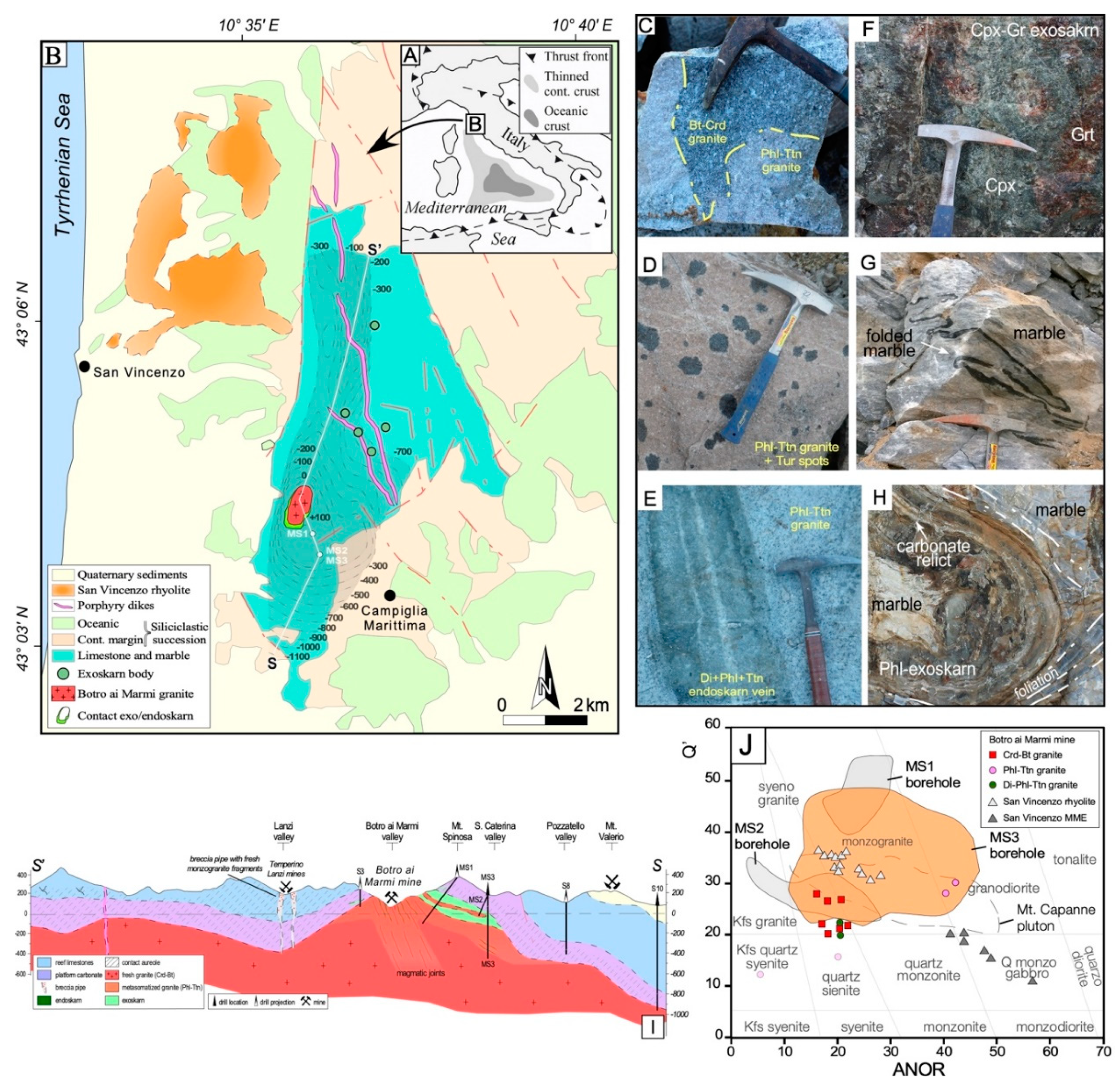
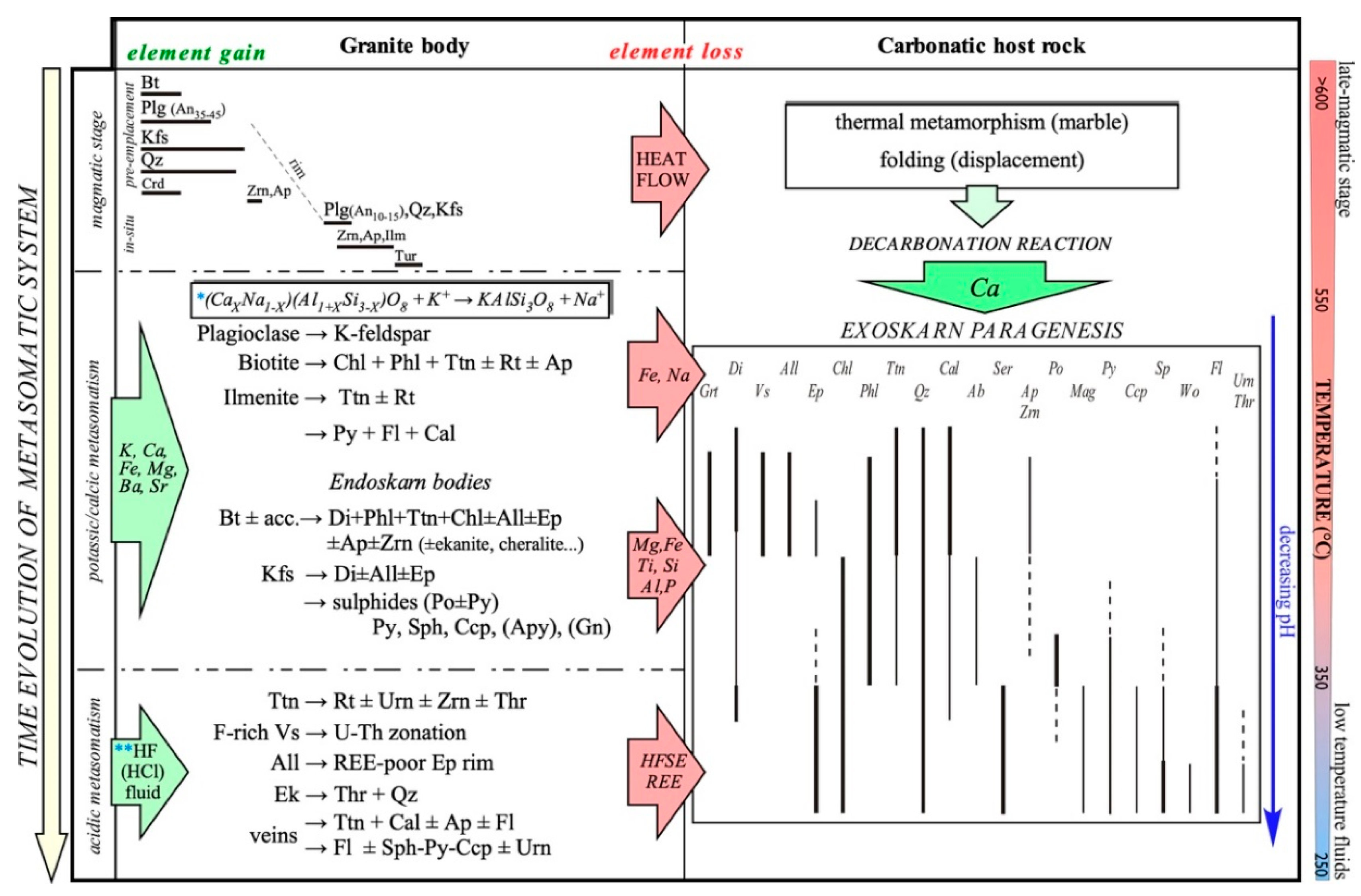
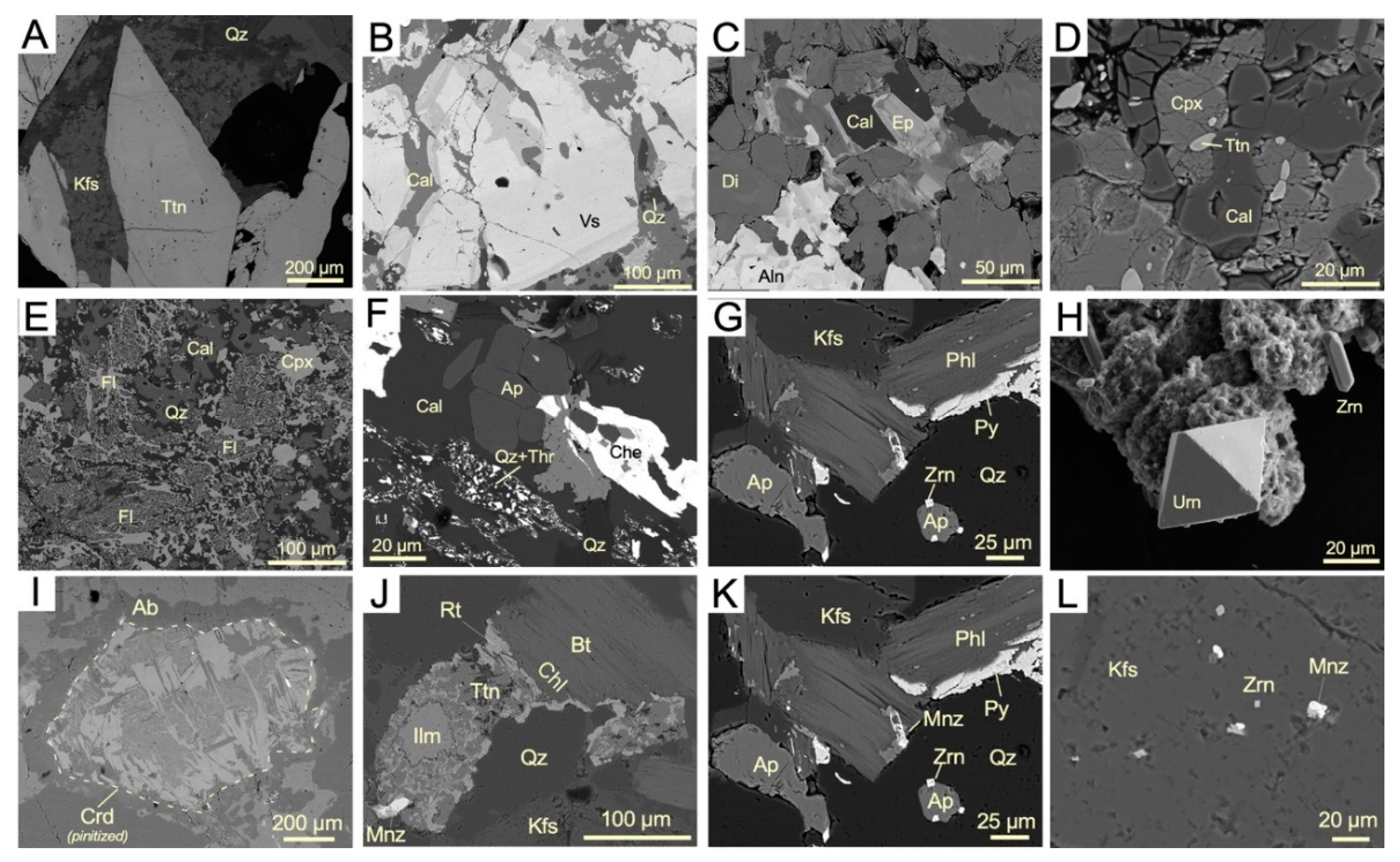
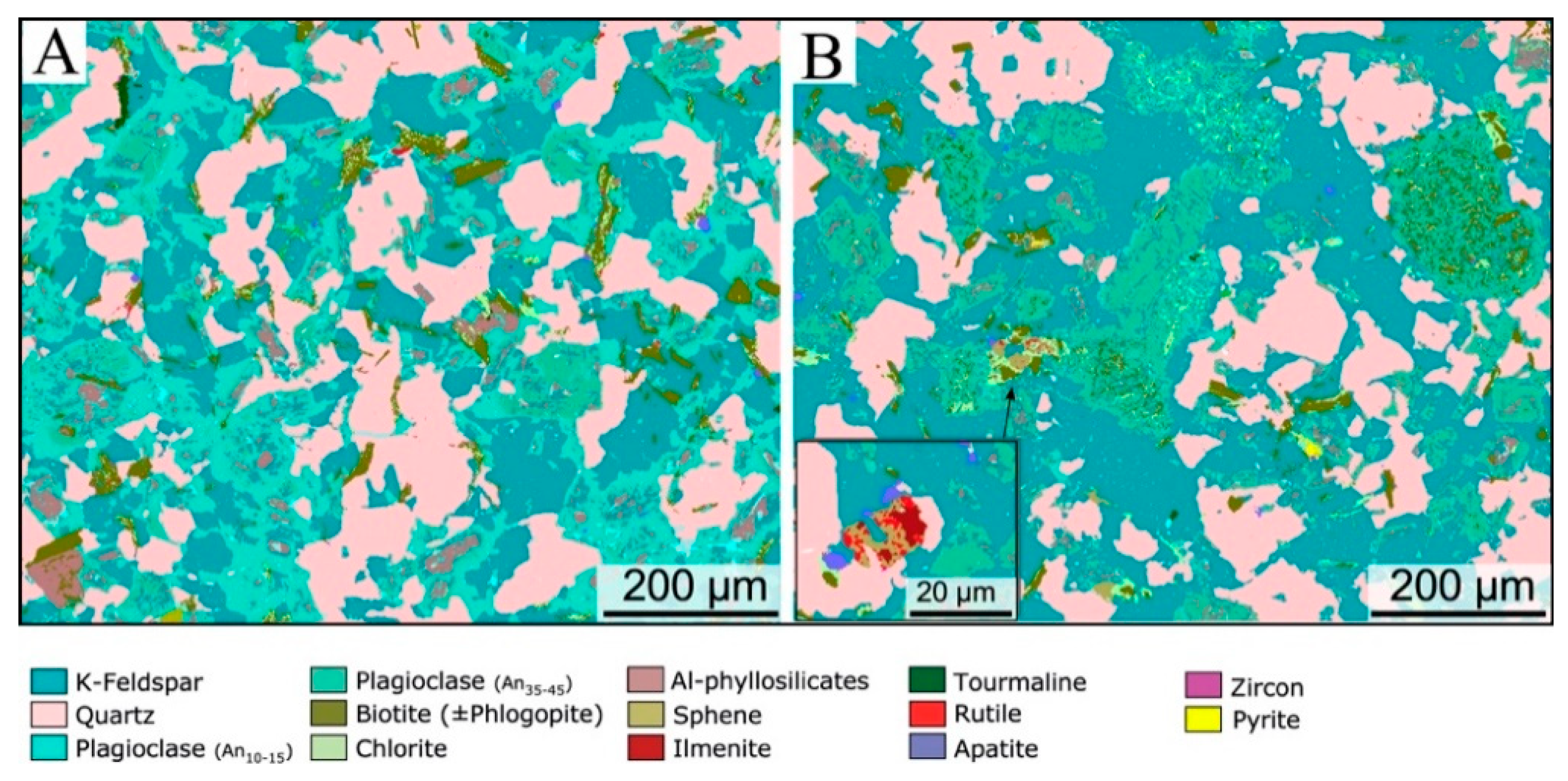
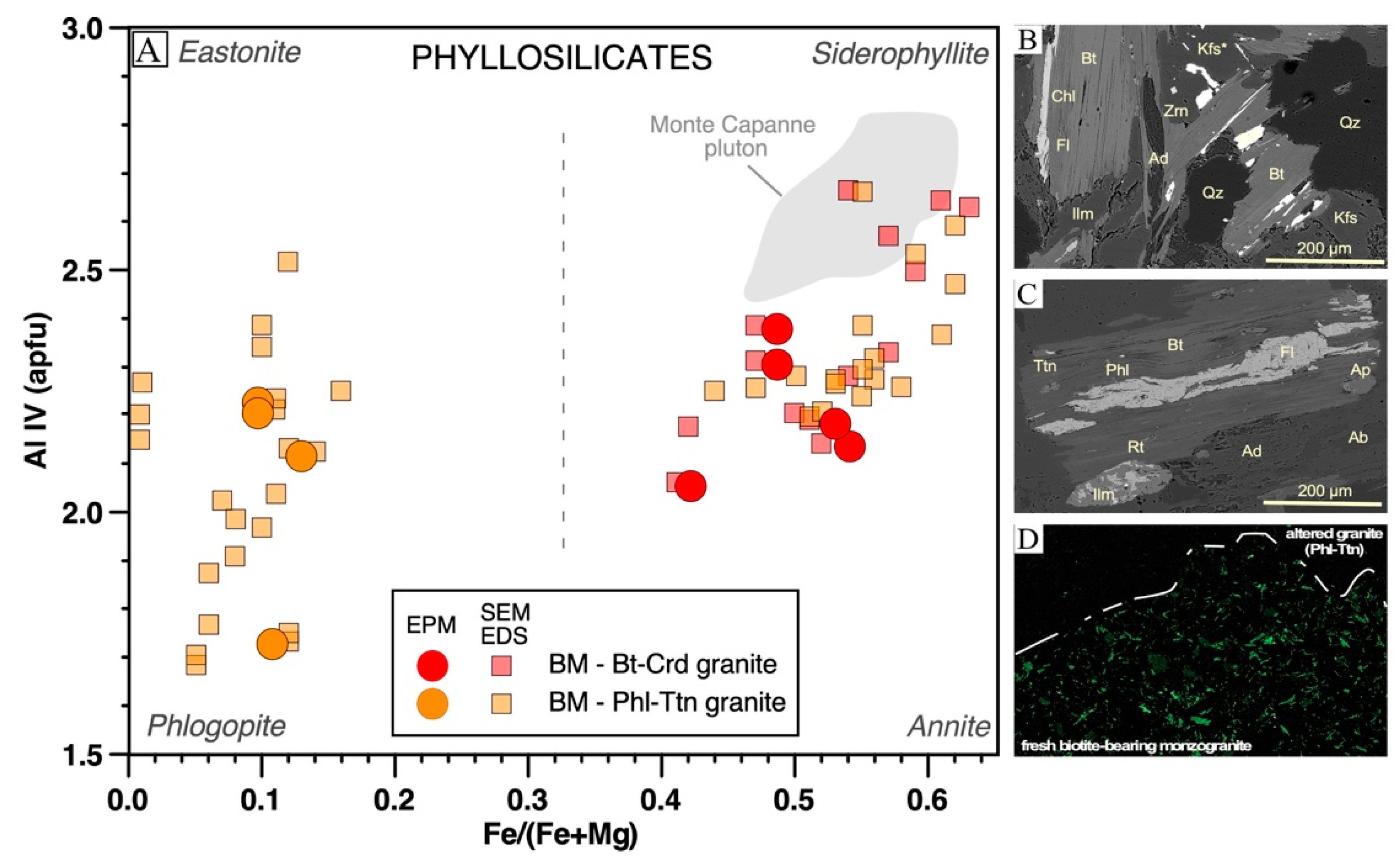

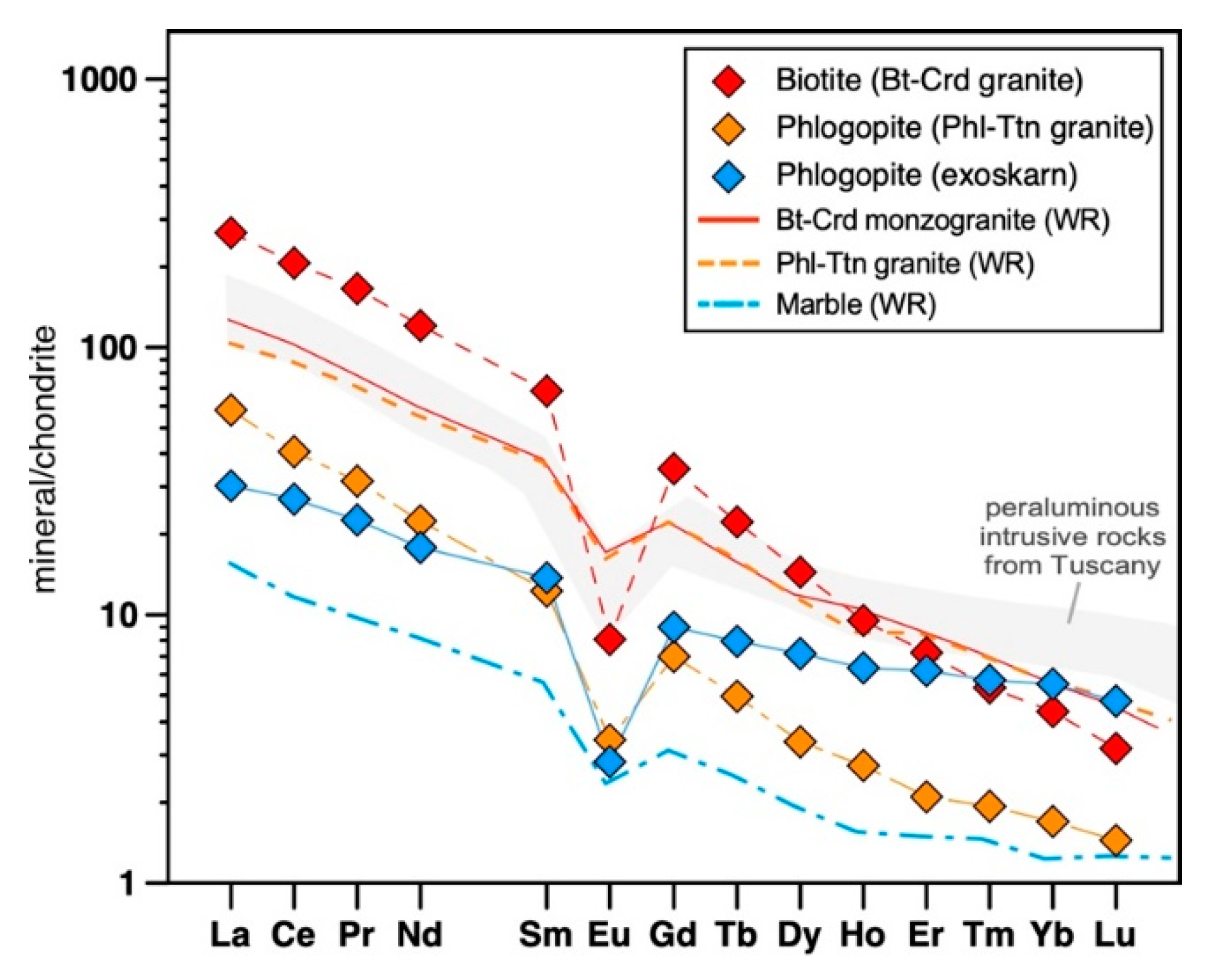
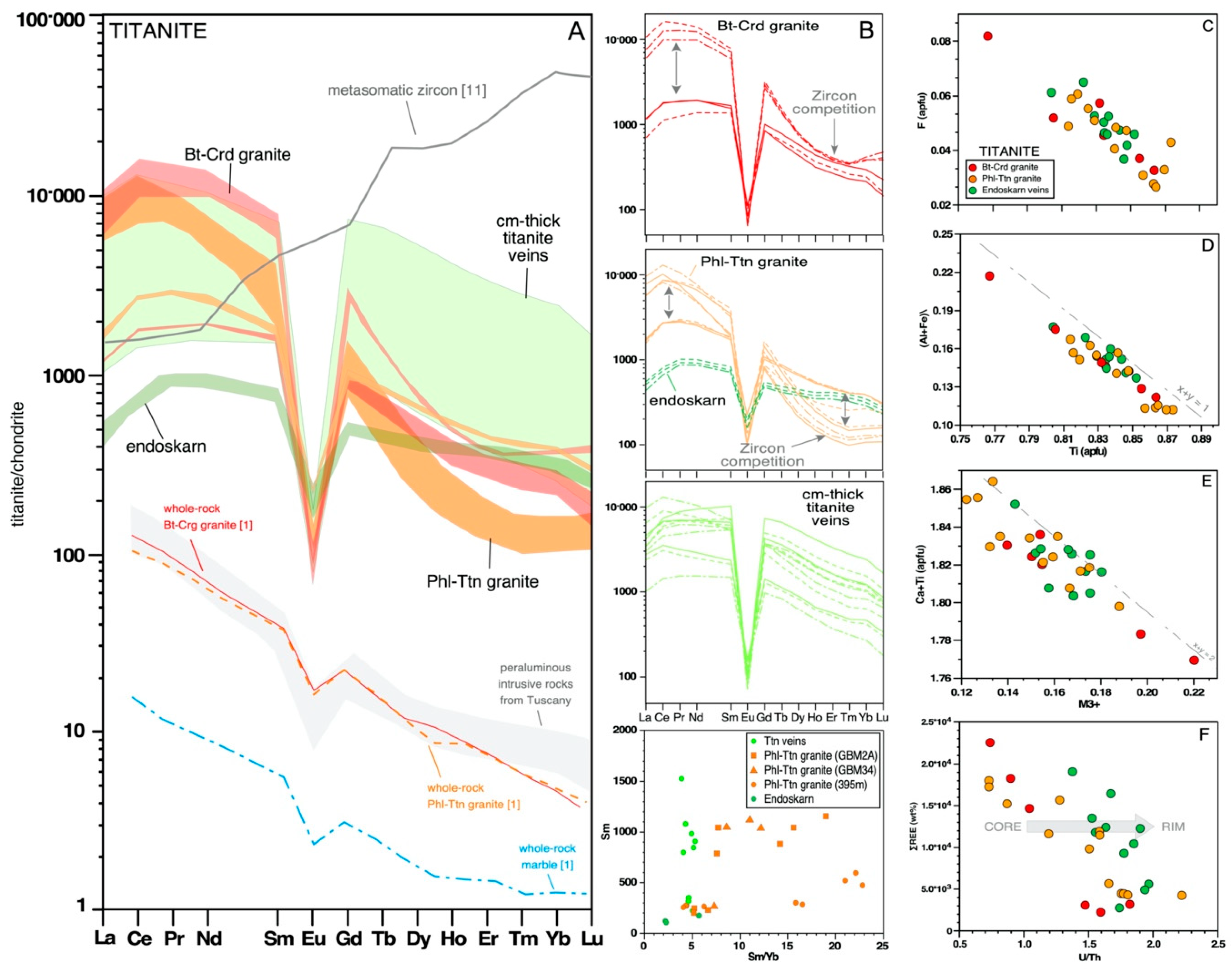
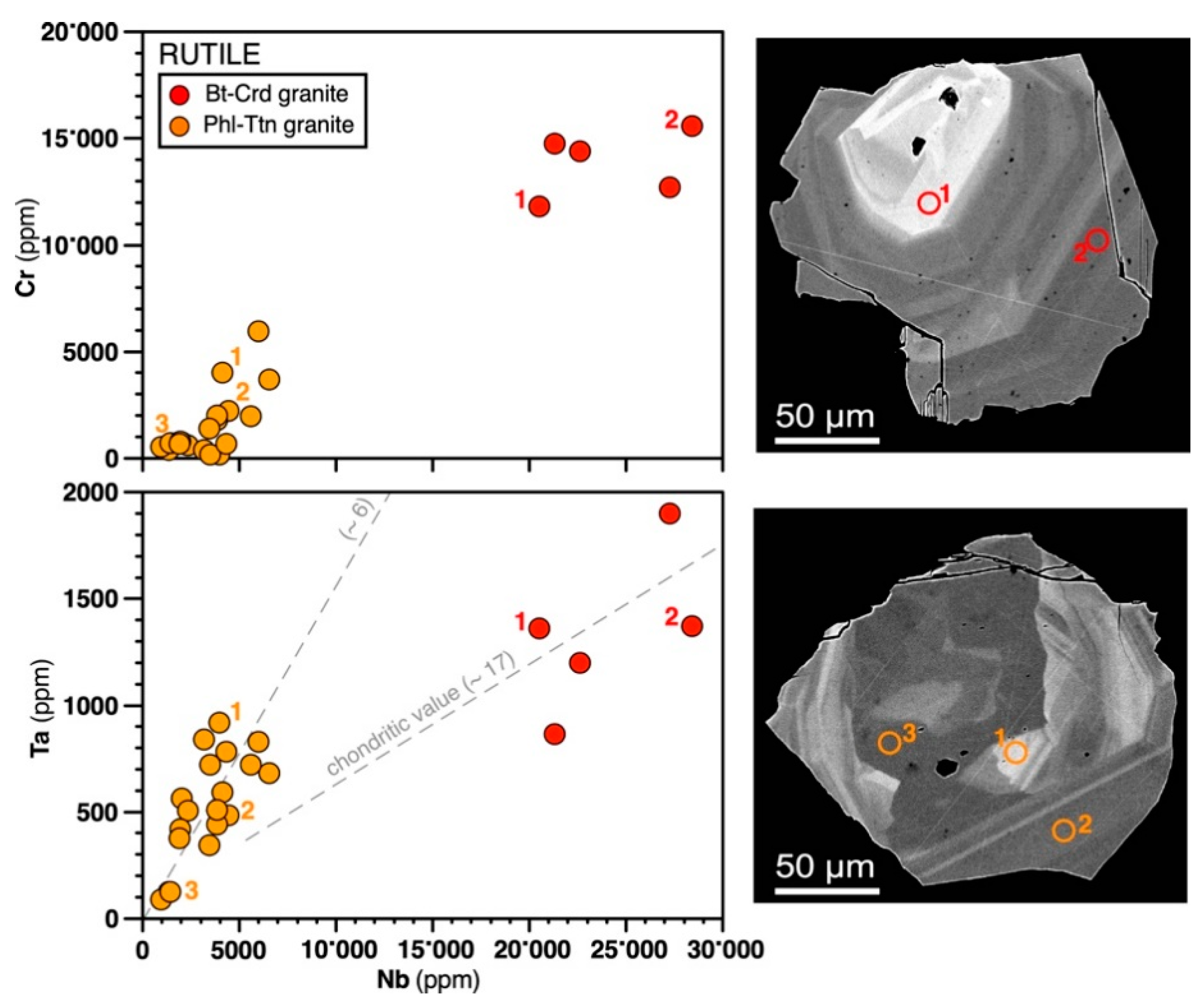
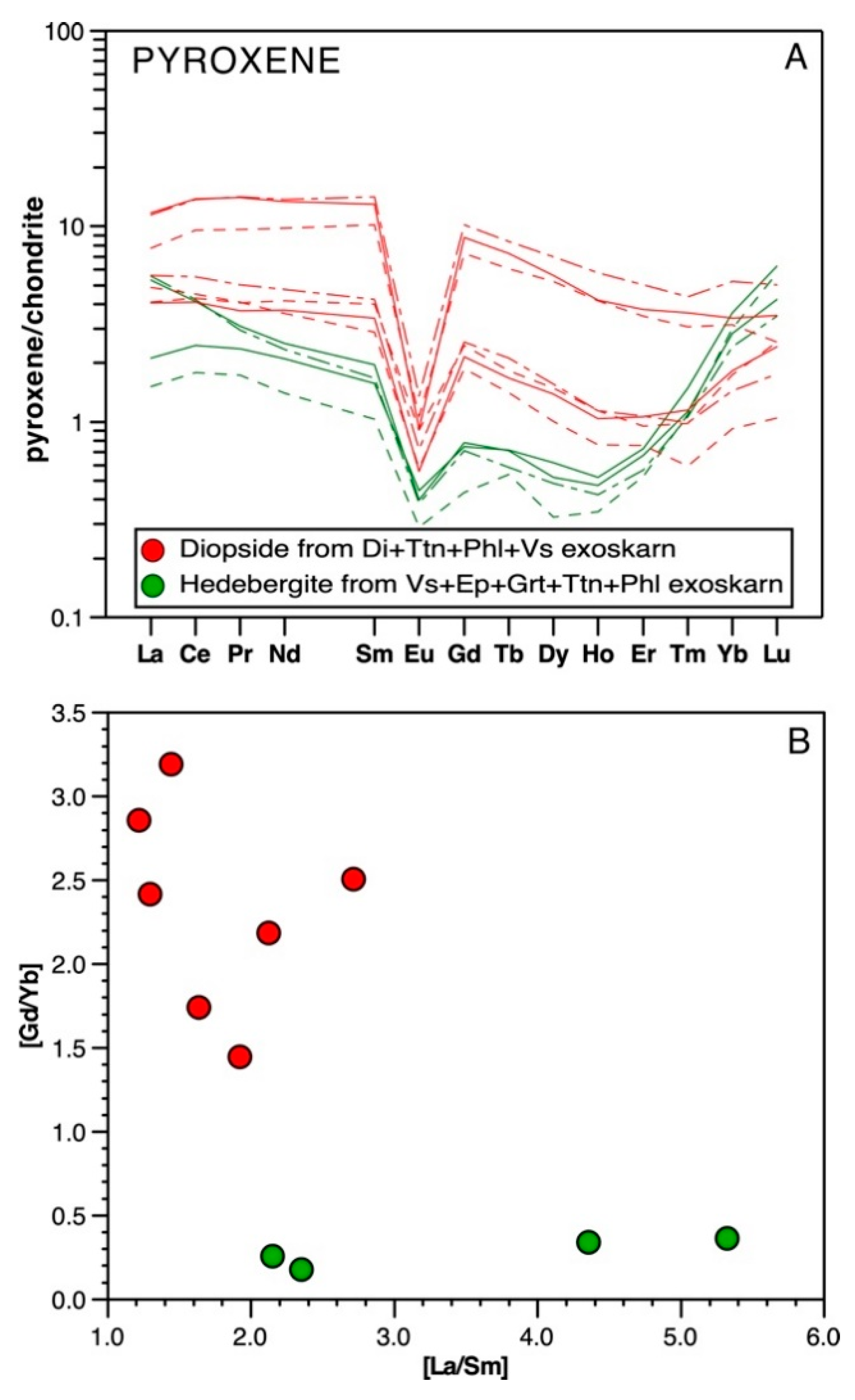
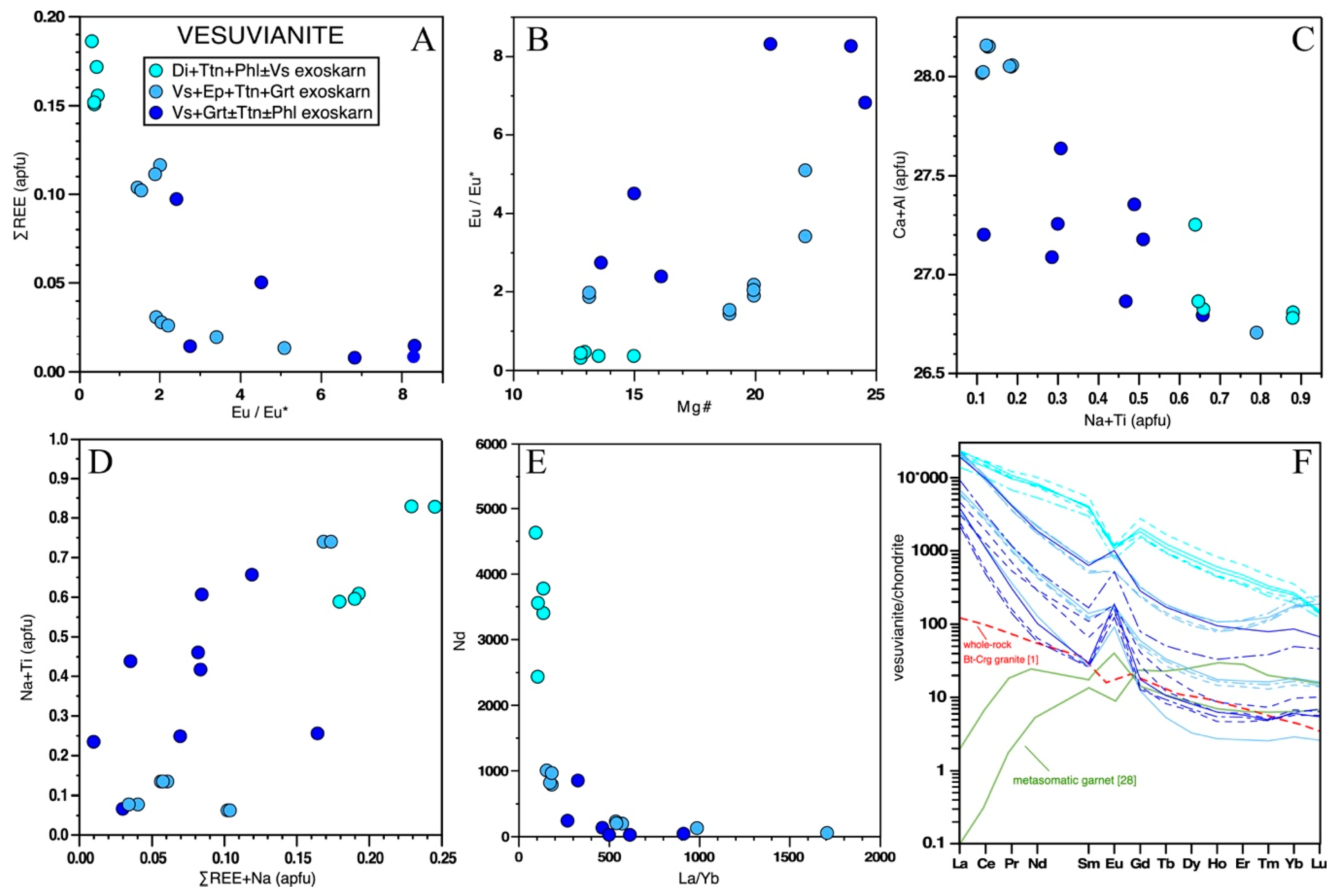

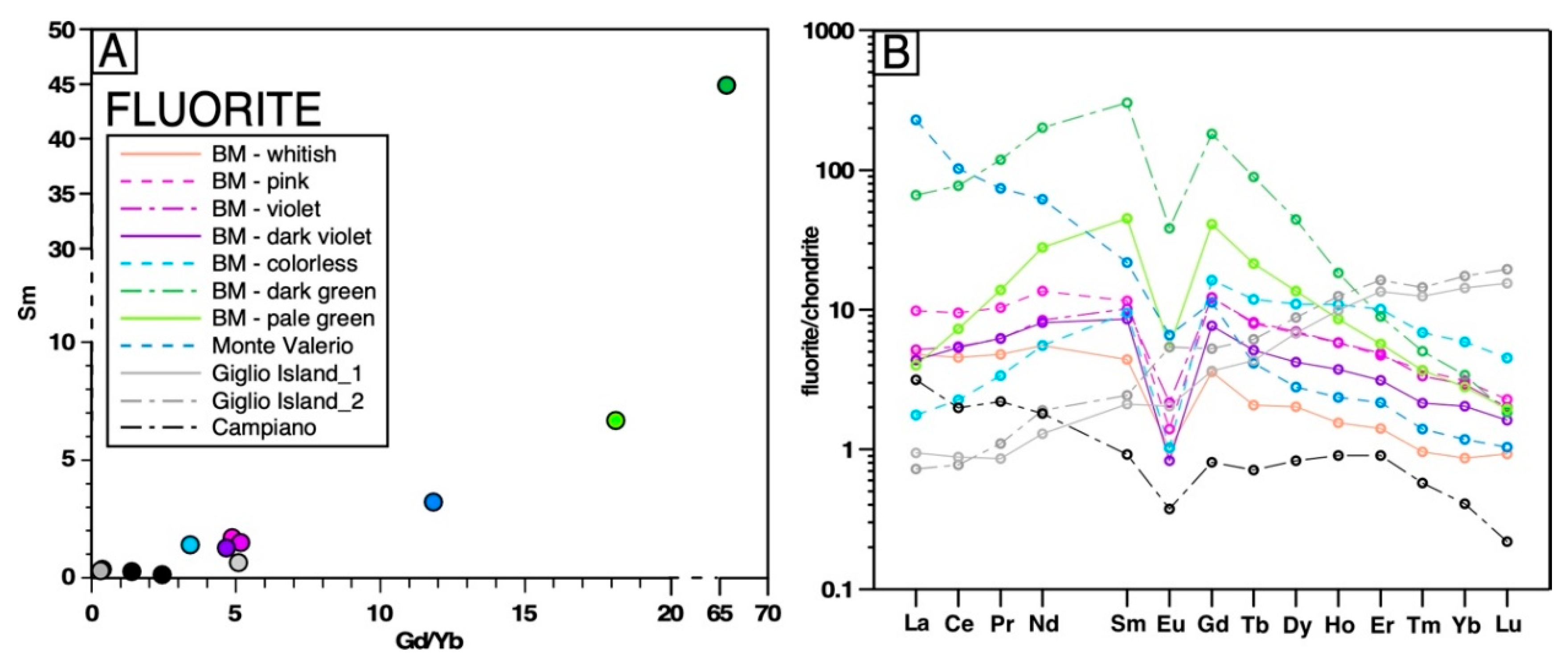
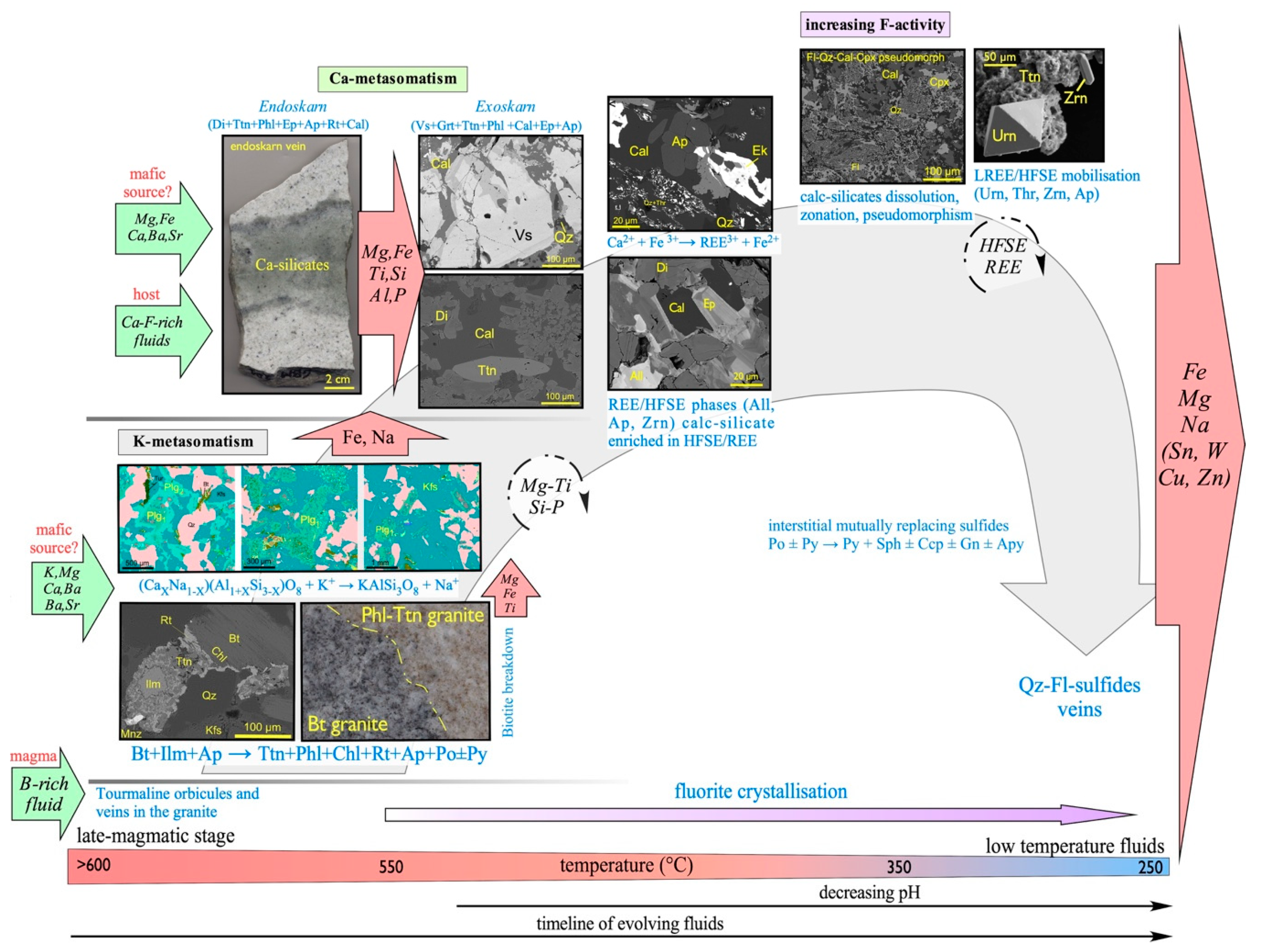
| Origin | General Group | Min. Name | Mineral Chemistry | Abundance (vol. %) | ||||||
|---|---|---|---|---|---|---|---|---|---|---|
| Symbol | Main Features | Crd-Bt Granite | Phl-Ttn Granite | Endoskarn | Di-Exoskarn | Phl-Exoskarn | Grt-Vs Exoskarn | |||
| Magmatic | Quartz | Quartz | Qz | 30–35 | 40–45 | 5–10 | ∗∗∗ | ∗∗ | ||
| Feldspar gr. | Plagioclase | Ab | 5–10 | ∗∗∗ | ∗∗∗ | ∗∗∗ | ∗∗∗ | |||
| An | 15–20 | 5–10 | 5–10 | ∗∗∗ | ∗∗ | ∗∗ | ||||
| K-feldspar | Kfs | 30–35 | 20–25 | ∗∗∗ | ∗∗∗ | ∗∗∗ | ∗∗ | |||
| Phyllosilicate | Micas | Bi | TiO2 > 3 wt %, Fe > Mg | 5–10 | ∗∗ | ∗∗ | ||||
| HFSE-REE min. | Phosphates | Ap | ∗ | ∗ | ∗ | |||||
| Mnz | ∗ | ∗ | ∗ | |||||||
| Zircon | Zrn | ∗ | ∗ | ∗ | ||||||
| Tourmaline | Tourmaline | Tur | ∗∗∗ | ∗∗∗ | ||||||
| Matasomatic | Quartz | Quartz | Qz | ∗∗∗ | ∗∗∗ | ∗∗∗ | ∗∗∗ | |||
| Feldspar gr. | Plagioclase | Ab | ∗∗∗ | ∗∗∗ | ||||||
| K-feldspar | Kfs | 5–10 | ∗∗∗ | ∗∗∗ | ∗∗∗ | |||||
| Phyllosilicate | Micas | Bi | High TiO2 > 3 wt %, Fe > Mg | ∗∗ | ||||||
| Phlogopite | Phl | Mg >> Fe, << F, Nb, Nd, LREE | 5–10 | 5–10 | 5–10 | 30–35 | 5–10 | |||
| Chlorite | Chl | Mg >> Fe, K, trace F | ∗∗∗ | ∗∗∗ | ∗∗∗ | ∗∗∗ | ∗∗∗ | |||
| Ti-minerals | Ti-minerals | Ttn | high Al, HFSE, LREE, F | ∗∗∗ | 5–10 | 5–10 | 5–10 | 5–10 | ||
| Rt | Nb, Cr, V, Al, Zr, Sc, Sn | ∗ | ∗ | ∗ | ∗ | ∗ | ||||
| Calc-silicates | Pyroxene | Di | Zn, Na | ∗∗ | 15–25 | 15–25 | 25–35 | 5–10 | ||
| Hd | Zn, Na | ∗∗∗ | ||||||||
| Vesuvianite | Vs | Th, U, LREE, F, Li, Be, Zn, Zr | ∗∗ | ∗∗∗ | ∗∗∗ | 20–40 | ||||
| Garnet | Gr | ∗∗ | ∗∗∗ | ∗∗∗ | 11232 | |||||
| Ad | ∗∗ | ∗∗ | ∗∗∗ | |||||||
| Epidote gr. | Ep | Sr, Sn, Sb, Th, U | ∗ | ∗∗∗ | ∗∗∗ | ∗∗∗ | ∗∗∗ | |||
| All | Sr, Sn, Sb, Th, U | ∗ | ∗∗∗ | ∗∗∗ | ∗∗∗ | ∗∗∗ | ||||
| Calcite | Cal | ∗∗ | 5–10 | 5–10 | 15–20 | ∗∗∗ | ||||
| HFSE-REE min. | Phosphates | Ap | F | ∗ | ∗ | ∗∗ | ∗∗ | ∗ | ||
| Mnz | ∗ | ∗ | ||||||||
| Che | ∗ | ∗ | ||||||||
| Zircon | Zrn | ∗ | ∗ | ∗ | ∗ | ∗ | ∗ | |||
| Th-U min. | Urn | Th | ∗ | ∗ | ∗ | ∗ | ∗ | ∗ | ||
| Thr | U | ∗ | ∗ | ∗ | ∗ | ∗ | ∗ | |||
| Fluorite | Fl | Sr, Y, LREE | ∗∗ | ∗∗ | ∗∗ | ∗∗ | ∗∗ | ∗∗ | ||
| Sulfides | Py | ∗∗∗ | ∗∗∗ | ∗∗∗ | ∗∗∗ | ∗∗∗ | ∗∗∗ | |||
| Po | ∗∗ | ∗∗∗ | ∗∗∗ | ∗∗ | ∗∗ | ∗∗∗ | ||||
| Sp | ∗∗ | ∗∗ | ∗∗ | ∗∗ | ∗∗ | ∗∗ | ||||
| Ccp | ∗∗ | ∗∗ | ∗∗ | ∗∗ | ∗∗ | ∗∗ | ||||
| Gn | ∗∗ | ∗∗ | ∗∗ | ∗∗ | ∗∗ | ∗∗ | ||||
| Rock Type | Bt-Crd Granite | Phl-Ttn Granite | Bt-Crd Granite | Bt-Crd Granite | Phl-Ttn Granite | |||||||
|---|---|---|---|---|---|---|---|---|---|---|---|---|
| Mineral | Kfs1 | Kfs2 | Kfs4 | Kfs5 | Plg-5r | Plg-5m | Plg-5c | Bt (BM5) | Phl (GBM2A) | |||
| SiO2 | 65.7 | 65.7 | 65.9 | 65.4 | 67.3 | 60.4 | 57.7 | 38.3 | 38.2 | 51.4 | 40.3 | 41.8 |
| TiO2 | bdl | bdl | 0.02 | 0.01 | bdl | 0.02 | bdl | 3.70 | 3.59 | 1.52 | 0.58 | 2.08 |
| Al2O3 | 19.5 | 19.2 | 19.6 | 19.5 | 21.5 | 26.0 | 27.8 | 15.5 | 15.6 | 6.27 | 14.5 | 13.3 |
| Cr2O3 | 0.02 | bdl | bdl | 0.03 | bdl | bdl | bdl | bdl | bdl | bdl | 0.02 | 0.02 |
| FeO | bdl | bdl | 0.03 | bdl | 0.02 | bdl | 0.20 | 17.8 | 17.2 | 1.29 | 4.94 | 6.24 |
| Mno | bdl | 0.01 | bdl | bdl | bdl | 0.01 | 0.02 | 0.28 | 0.27 | bdl | 0.04 | 0.04 |
| MgO | 0.02 | 0.02 | bdl | 0.03 | bdl | bdl | 0.01 | 9.57 | 8.92 | 23.8 | 22.1 | 20.7 |
| CaO | 0.08 | 0.03 | 0.10 | 0.08 | 2.96 | 6.90 | 8.70 | 0.11 | 0.05 | 0.01 | bdl | 0.03 |
| Na2O | 1.92 | 1.70 | 1.99 | 1.63 | 8.80 | 7.20 | 6.00 | 0.06 | 0.21 | 0.10 | 0.23 | 0.07 |
| K2O | 14.2 | 15.0 | 13.8 | 14.7 | 0.23 | 0.16 | 0.18 | 8.47 | 8.41 | 9.96 | 10.4 | 10.2 |
| F | nd | nd | nd | nd | nd | nd | nd | 0.37 | 0.41 | 3.05 | 1.37 | 2.31 |
| Mg# | nd | nd | nd | nd | nd | nd | nd | 0.49 | 0.48 | 0.97 | 0.89 | 0.86 |
| Fe# | nd | nd | nd | nd | nd | nd | nd | 0.51 | 0.52 | 0.03 | 0.11 | 0.14 |
| Total | 101.4 | 101.7 | 101.4 | 101.4 | 100.8 | 100.7 | 100.6 | 94.2 | 92.9 | 97.4 | 94.5 | 96.8 |
| Rock Type | Bt-Crd Granite | Phl-Ttn Granite | Veins | Phl-Ttn Granite (−395 m) | ||||||
|---|---|---|---|---|---|---|---|---|---|---|
| Mineral | Ttn8 | Ttn9 | Ttn10 | Ttn13 | Ttn13_2 | Ttn1 | Ttn4 | Ttn5 | Ttn14 | Ttn15 |
| SiO2 | 31.3 | 30.5 | 30.9 | 30.5 | 30.8 | 30.8 | 31.8 | 30.8 | 30.7 | 30.6 |
| TiO2 | 33.6 | 33.9 | 32.0 | 35.0 | 33.6 | 33.4 | 31.2 | 34.4 | 33.9 | 34.2 |
| Al2O3 | 3.70 | 3.15 | 4.26 | 2.64 | 3.85 | 3.68 | 5.55 | 2.92 | 3.41 | 2.76 |
| FeO | 0.20 | 0.16 | 0.25 | 0.33 | 0.21 | 0.27 | 0.11 | 0.25 | 0.33 | 0.22 |
| MnO | 0.00 | 0.03 | 0.00 | 0.06 | 0.02 | 0.05 | 0.01 | 0.04 | 0.01 | 0.02 |
| MgO | 0.10 | 0.16 | 0.20 | 0.07 | 0.16 | 0.17 | 0.07 | 0.19 | 0.25 | 0.10 |
| CaO | 28.5 | 26.9 | 27.3 | 27.9 | 27.1 | 27.9 | 28.6 | 27.0 | 27.7 | 27.5 |
| Na2O | 0.02 | 0.08 | 0.04 | 0.04 | 0.07 | 0.03 | 0.00 | 0.06 | 0.09 | 0.05 |
| Nb2O5 | 0.08 | 0.35 | 0.10 | 0.17 | 0.13 | 0.04 | 0.17 | 0.36 | 0.29 | 0.32 |
| La2O3 | 0.03 | 0.14 | 0.15 | 0.19 | 0.12 | 0.05 | 0.00 | 0.22 | 0.12 | 0.22 |
| Ce2O3 | 0.02 | 1.08 | 1.00 | 0.58 | 0.07 | 0.56 | 0.13 | 1.17 | 1.01 | 0.85 |
| Sm2O3 | 0.16 | 0.15 | 0.06 | 0.18 | 0.04 | 0.00 | 0.01 | 0.14 | 0.14 | 0.03 |
| Nd2O3 | 0.03 | 0.76 | 0.78 | 0.23 | 0.16 | 0.24 | 0.18 | 0.83 | 0.51 | 0.47 |
| F | 0.55 | 0.35 | 0.49 | 0.41 | 0.46 | 0.48 | 0.79 | 0.31 | 0.45 | 0.25 |
| Total | 100.7 | 99.9 | 99.6 | 100.6 | 99.2 | 100.0 | 100.7 | 100.7 | 101.2 | 99.9 |
| Trace element (ppm)–LA-ICP-MS | ||||||||||
| Li | 5.2 | 24 | 9.5 | 15 | 1.81 | 11 | 5.3 | 9.4 | 6.8 | 6.7 |
| Be | 0.02 | 1.10 | 0.22 | 1.67 | bdl | 0.20 | 0.08 | 0.16 | bdl | bdl |
| Sc | 42 | 247 | 328 | 372 | 389 | 257 | 11 | 663 | 162 | 167 |
| V | 920 | 1075 | 1476 | 1105 | 2398 | 1451 | 476 | 1487 | 1636 | 1661 |
| Cr | 636 | 603 | 964 | 1323 | 1422 | 904 | 403 | 860 | 786 | 803 |
| Mn | 87 | 169 | 155 | 168 | 99 | 191 | 90 | 154 | 116 | 118 |
| Co | 0.11 | 0.15 | 0.17 | 0.21 | bdl | 0.12 | 0.11 | 0.11 | bdl | bdl |
| Ni | 0.43 | 0.39 | 0.41 | 1.64 | 0.34 | 0.39 | 0.55 | 0.66 | 0.32 | 0.35 |
| Cu | 9.0 | 9.3 | 8.4 | 8.9 | 8.1 | 8.0 | 8.6 | 8.4 | 7.8 | 8.2 |
| Zn | 8.0 | 8.8 | 8.1 | 11 | 8.3 | 8.8 | 8.7 | 9.8 | 7.5 | 7.6 |
| Ga | 18 | 66 | 60 | 54 | 27 | 41 | 16 | 47 | 22 | 22 |
| Rb | 0.25 | bdl | 0.10 | 5.9 | bdl | 0.51 | 0.13 | 0.46 | bdl | 0.07 |
| Sr | 17 | 31 | 23 | 16 | 15 | 22 | 20 | 25 | 16 | 16 |
| Y | 633 | 733 | 726 | 1239 | 482 | 1487 | 540 | 777 | 797 | 818 |
| Zr | 433 | 757 | 516 | 1710 | 1070 | 444 | 405 | 1313 | 965 | 966 |
| Nb | 816 | 2440 | 843 | 1388 | 639 | 828 | 720 | 840 | 1913 | 1952 |
| Sn | 246 | 91 | 74 | 245 | 133 | 43 | 243 | 108 | 407 | 391 |
| Sb | bdl | bdl | 0.16 | 0.60 | bdl | 0.06 | 0.12 | 0.08 | 0.08 | bdl |
| Cs | 0.21 | bdl | bdl | 0.62 | 0.02 | 0.26 | 0.08 | 0.08 | bdl | bdl |
| Ba | 0.02 | 0.04 | 0.04 | 0.56 | bdl | 0.07 | 0.17 | 0.41 | bdl | 0.01 |
| La | 282 | 2551 | 1816 | 2265 | 740 | 1558 | 168 | 1446 | 421 | 414 |
| Ce | 1090 | 9910 | 7650 | 7110 | 2499 | 5540 | 688 | 6020 | 1679 | 1689 |
| Pr | 175 | 1432 | 1181 | 994 | 336 | 771 | 116 | 906 | 268 | 269 |
| Nd | 871 | 6420 | 5590 | 4410 | 1377 | 3502 | 628 | 4480 | 1212 | 1199 |
| Sm | 247 | 1157 | 1044 | 1044 | 275 | 788 | 203 | 883 | 275 | 275 |
| Eu | 6.2 | 3.8 | 3.6 | 11 | 9.6 | 5.6 | 5.7 | 3.9 | 13 | 13 |
| Gd | 200 | 638 | 588 | 739 | 195 | 582 | 166 | 533 | 214 | 213 |
| Tb | 28 | 55 | 50 | 84 | 23 | 73 | 23 | 48 | 32 | 32 |
| Dy | 142 | 193 | 182 | 346 | 106 | 356 | 121 | 192 | 168 | 170 |
| Ho | 24 | 27 | 27 | 51 | 18 | 56 | 20 | 28 | 30 | 30 |
| Er | 58 | 61 | 62 | 110 | 44 | 133 | 50 | 65 | 75 | 76 |
| Tm | 8.0 | 8.4 | 8.6 | 14 | 5.8 | 17 | 6.4 | 8.7 | 10 | 10 |
| Yb | 47 | 61 | 67 | 86 | 38 | 104 | 39 | 62 | 63 | 63 |
| Lu | 5.5 | 10 | 12 | 11 | 5.4 | 13 | 3.9 | 9.4 | 7.4 | 7.5 |
| Hf | 47 | 38 | 32 | 114 | 70 | 34 | 27 | 72 | 61 | 61 |
| Ta | 243 | 351 | 140 | 239 | 70 | 102 | 117 | 132 | 172 | 175 |
| Pb | 0.26 | 1.46 | 0.39 | 3.9 | 0.24 | 0.43 | 0.70 | 0.51 | 0.28 | 0.27 |
| Bi | 0.13 | 0.15 | 0.21 | 0.31 | 0.12 | 0.16 | 0.14 | 0.14 | 0.16 | 0.16 |
| Th | 83 | 374 | 349 | 335 | 161 | 258 | 123 | 170 | 225 | 221 |
| U | 151 | 276 | 313 | 244 | 267 | 394 | 196 | 177 | 395 | 392 |
| Rock | Exoskarn | Endoskarn | ||||
|---|---|---|---|---|---|---|
| Mineral | Cpx1_rim | Cpx2_core | Cpx2_rim | Px27 _rim | Px27 _mid | Px27_core |
| SiO2 | 51.0 | 51.8 | 50.7 | 53.7 | 55.1 | 55.2 |
| TiO2 | 0.06 | 0.00 | 0.03 | 0.00 | 0.00 | 0.09 |
| Al2O3 | 0.28 | 0.13 | 0.36 | 0.22 | 0.18 | 0.05 |
| Cr2O3 | Nd | nd | nd | nd | nd | nd |
| FeO | 22.9 | 18.9 | 23.3 | 8.18 | 2.98 | 2.28 |
| Mno | 0.56 | 0.48 | 0.55 | 0.22 | 0.07 | 0.04 |
| MgO | 3.18 | 6.01 | 3.58 | 13.1 | 16.3 | 16.9 |
| CaO | 23.1 | 22.9 | 23.2 | 25.0 | 25.2 | 25.5 |
| Na2O | 0.10 | 0.12 | 0.09 | 0.11 | 0.00 | 0.00 |
| K2O | 0.00 | 0.00 | 0.00 | 0.00 | 0.01 | 0.00 |
| F | nd | nd | nd | nd | nd | nd |
| Mg# | nd | nd | nd | nd | nd | nd |
| Fe# | nd | nd | nd | nd | nd | nd |
| Total | 101.2 | 100.6 | 101.9 | 100.7 | 100.0 | 100.2 |
| Trace element (ppm)—LA-ICP-MS | ||||||
| Li | 56 | 89 | 55 | 106 | 34 | 9.82 |
| Be | 1.54 | 3.29 | 1.93 | 4.30 | 19 | 17 |
| Sc | 5.47 | 5.60 | 5.47 | 5.38 | 5.44 | 5.77 |
| V | 17 | 27 | 16 | 18 | 16 | 10 |
| Cr | 9.25 | 7.70 | 6.80 | 2.57 | 1.40 | 3.06 |
| Mn | 4740 | 5113 | 4831 | 1532 | 612 | 468 |
| Co | 21 | 12.1 | 20 | 11 | 2.34 | 1.89 |
| Ni | 5.70 | 5.33 | 3.30 | 24 | 1.71 | 0.36 |
| Cu | bdl | 0.21 | bdl | 0.27 | 0.44 | 0.26 |
| Zn | 410 | 397 | 421 | 116 | 44 | 35 |
| Ga | 6.23 | 5.69 | 7.13 | 4.15 | 4.68 | 2.67 |
| Rb | bdl | bdl | bdl | 1.80 | 1.03 | 0.09 |
| Sr | 22 | 20 | 25 | 15 | 12 | 11 |
| Y | 0.78 | 0.51 | 0.84 | 1.60 | 8.95 | 6.10 |
| Zr | 5.89 | 2.35 | 8.38 | 4.14 | 11 | 3.37 |
| Nb | 0.00 | bdl | 0.01 | 0.01 | 0.31 | 0.01 |
| Sn | 6.19 | 5.38 | 8.73 | 6.32 | 7.81 | 2.11 |
| Sb | 0.05 | 0.05 | 0.07 | 0.37 | 0.18 | 0.04 |
| Cs | bdl | 0.03 | bdl | 3.94 | 1.41 | 0.05 |
| Ba | 0.03 | 0.02 | 0.02 | 1.57 | 0.78 | 0.02 |
| La | 1.26 | 0.34 | 1.31 | 0.96 | 2.72 | 1.84 |
| Ce | 2.54 | 1.03 | 2.59 | 2.52 | 8.44 | 5.86 |
| Pr | 0.29 | 0.15 | 0.27 | 0.34 | 1.31 | 0.90 |
| Nd | 1.15 | 0.60 | 1.08 | 1.71 | 6.26 | 4.49 |
| Sm | 0.29 | 0.14 | 0.25 | 0.50 | 2.10 | 1.51 |
| Eu | 0.02 | 0.02 | 0.02 | 0.03 | 0.08 | 0.06 |
| Gd | 0.16 | 0.08 | 0.14 | 0.43 | 2.03 | 1.44 |
| Tb | 0.03 | 0.02 | 0.02 | 0.06 | 0.30 | 0.22 |
| Dy | 0.13 | 0.08 | 0.12 | 0.34 | 1.72 | 1.28 |
| Ho | 0.03 | 0.02 | 0.02 | 0.06 | 0.32 | 0.23 |
| Er | 0.11 | 0.08 | 0.09 | 0.17 | 0.80 | 0.56 |
| Tm | 0.03 | 0.03 | 0.03 | 0.03 | 0.11 | 0.08 |
| Yb | 0.46 | 0.45 | 0.39 | 0.30 | 0.84 | 0.51 |
| Lu | 0.10 | 0.13 | 0.09 | 0.06 | 0.12 | 0.06 |
| Hf | 0.31 | 0.22 | 0.42 | 0.25 | 0.28 | 0.12 |
| Ta | bdl | 0.00 | 0.00 | 0.00 | 0.34 | 0.01 |
| Pb | 0.21 | 0.14 | 0.18 | 0.40 | 0.76 | 0.10 |
| Bi | 0.01 | 0.01 | 0.01 | 0.05 | 0.05 | 0.01 |
| Th | 0.02 | 0.01 | 0.01 | 0.13 | 0.08 | 0.01 |
| U | 0.01 | 0.02 | 0.02 | 0.09 | 0.06 | 0.01 |
| Rock | Di Exoskarn (GBM46) | Grt-Vs Exoskarn (STAB1) | Vs Exoskarn (GBM45) | |||||||||
|---|---|---|---|---|---|---|---|---|---|---|---|---|
| Mineral | Vs7_core | Vs7_rim | Vs1.1 | Vs1.2 | Vs 2.1 | Vs 2.1 | Ep1 | Ep4_core | Ep4_rim | All3.5_core | All3.5_mid | All3.5_rim |
| SiO2 | 36.2 | 36.0 | 37.0 | 36.9 | 36.2 | 35.8 | 36.6 | 38.0 | 37.5 | 34.0 | 33.5 | 33.6 |
| TiO2 | 1.49 | 2.06 | 0.29 | 1.85 | 1.64 | 1.44 | 0.01 | 0.00 | 0.29 | 0.28 | 0.36 | 0.21 |
| Al2O3 | 15.2 | 14.9 | 16.9 | 15.1 | 15.1 | 14.9 | 19.6 | 19.6 | 19.6 | 20.7 | 20.0 | 18.4 |
| FeO | 6.34 | 6.22 | 5.34 | 6.82 | 7.04 | 6.73 | 15.5 | 16.3 | 16.4 | 8.24 | 8.88 | 8.86 |
| MnO | 0.43 | 0.11 | 0.07 | 0.09 | 0.10 | 0.19 | 0.29 | 0.10 | 0.08 | 0.10 | 0.12 | 0.07 |
| MgO | 0.99 | 0.91 | 1.33 | 1.03 | 0.72 | 1.11 | 0.00 | 0.00 | 0.00 | 1.21 | 1.25 | 2.11 |
| CaO | 33.6 | 33.8 | 35.3 | 34.2 | 32.4 | 33.0 | 19.5 | 22.7 | 21.3 | 13.2 | 12.6 | 11.1 |
| Na2O | 0.04 | 0.06 | 0.03 | 0.06 | 0.09 | 0.06 | 0.00 | 0.00 | 0.00 | 0.00 | 0.00 | 0.00 |
| Nb2O5 | 0.00 | 0.00 | 0.00 | 0.00 | 0.00 | 0.00 | 0.12 | 0.08 | 0.01 | 0.67 | 0.60 | 0.60 |
| La2O3 | 0.57 | 0.47 | 0.06 | 0.60 | 0.59 | 0.59 | 4.05 | 0.25 | 2.25 | 7.95 | 8.34 | 10.6 |
| Ce2O3 | 1.01 | 0.86 | 0.16 | 0.79 | 1.52 | 1.43 | 2.04 | 0.17 | 1.28 | 10.4 | 11.4 | 12.1 |
| Sm2O3 | 0.12 | 0.02 | 0.00 | 0.05 | 0.14 | 0.00 | 0.00 | 0.00 | 0.06 | 0.05 | 0.03 | 0.05 |
| Nd2O3 | 0.32 | 0.28 | 0.17 | 0.10 | 0.68 | 0.36 | 0.06 | 0.00 | 0.13 | 1.73 | 1.88 | 1.79 |
| F | 0.72 | 0.84 | 0.88 | 0.73 | 0.73 | 0.73 | 0.03 | 0.00 | 0.00 | 0.13 | 0.19 | 0.35 |
| Total | 97.4 | 96.6 | 97.5 | 98.3 | 97.0 | 96.4 | 97.7 | 97.3 | 98.8 | 98.5 | 99.0 | 99.4 |
| Trace element (ppm)—LA-ICP-MS | ||||||||||||
| Li | 272 | 194 | 114 | 157 | 206 | 171 | 4.0 | 4.2 | 7.4 | 244 | 125 | 254 |
| Be | 147 | 173 | 82 | 57 | 275 | 162 | 0.40 | 0.40 | 2.80 | 0.20 | 0.40 | 0.20 |
| Sc | 3.31 | 3.6 | 6.8 | 5.6 | 4.7 | 3.7 | 5.6 | 5.2 | 7.1 | 6.5 | 6.2 | 6.2 |
| V | 95 | 84 | 11.6 | 140 | 73 | 14.1 | 12.0 | 81 | 13.0 | 120 | 98 | 106 |
| Cr | 35 | 29.3 | 29.4 | 17.6 | 2.08 | 3.5 | bdl | 6.2 | 3.20 | 6.6 | 3.6 | 4.9 |
| Mn | 998 | 1106 | 1080 | 1066 | 1144 | 1092 | 1455 | 1322 | 19,200 | 914 | 837 | 921 |
| Co | 5.1 | 5.1 | 2.64 | 4.3 | 5.4 | 3.29 | bdl | bdl | 5.4 | 2.20 | 2.30 | 2.40 |
| Ni | 10.9 | 0.64 | 0.86 | 0.75 | 6.67 | 1.03 | 2.10 | 0.80 | 5.0 | bdl | Bdl | bdl |
| Cu | 0.54 | 0.52 | bdl | 0.58 | 0.31 | bdl | bdl | bdl | 2.90 | bdl | Bdl | bdl |
| Zn | 135 | 142 | 98 | 118 | 117 | 109 | 26 | 34 | 99 | 78 | 65 | 77 |
| Ga | 85 | 99 | 50 | 77 | 115 | 49 | 117 | 85 | 10 | 683 | 683 | 642 |
| Rb | bdl | 2.26 | bdl | 0.07 | 0.13 | bdl | bdl | bdl | 1.80 | bdl | 0.20 | 1.10 |
| Sr | 45 | 56 | 55 | 53 | 49 | 55 | 1051 | 1098 | 152 | 221 | 210 | 197 |
| Y | 587 | 769 | 26.61 | 170 | 1474 | 59 | 250 | 211 | 16 | 168 | 123 | 150 |
| Zr | 13.1 | 28.5 | 344 | 120 | 38 | 24.8 | 12.0 | 26.0 | 2.40 | 2.40 | 2.90 | 3.20 |
| Nb | 0.70 | 2.07 | 9.37 | 3.62 | 1.88 | 1.34 | 0.06 | 0.03 | 0.01 | 0.02 | 0.02 | 0.03 |
| Sn | 42 | 71 | 45 | 79 | 42 | 37 | 1753 | 1900 | 190 | 22.0 | 85 | 24.0 |
| Sb | 69 | 71 | 49 | 61 | 61 | 58 | 453 | 28.0 | 10.0 | bdl | Bdl | bdl |
| Cs | bdl | 2.09 | bdl | bdl | 0.01 | bdl | 0.04 | bdl | 1.12 | bdl | 0.07 | 0.54 |
| Ba | 0.00 | 0.24 | 0.00 | 0.02 | 0.03 | bdl | 1.30 | 0.47 | 3.9 | 0.13 | 0.20 | 1.30 |
| La | 3268 | 5480 | 1364 | 5400 | 5720 | 1038 | 56,600 | 47,400 | 2270 | 100,300 | 71,900 | 92,900 |
| Ce | 6120 | 9830 | 1523 | 6340 | 12,310 | 1308 | 30,300 | 19,700 | 1370 | 105,800 | 88,300 | 97,100 |
| Pr | 625 | 995 | 92 | 393 | 1296 | 99 | 1248 | 753 | 53 | 6677 | 6000 | 6030 |
| Nd | 2435 | 3780 | 197 | 1003 | 4770 | 301 | 2140 | 1430 | 81 | 15,690 | 14,590 | 14,090 |
| Sm | 443 | 577 | 17.4 | 103 | 754 | 47 | 162 | 133 | 8.8 | 1092 | 1063 | 977 |
| Eu | 44 | 66 | 9.3 | 53 | 96 | 10.8 | 12.9 | 17.7 | 1.39 | 23.4 | 24.1 | 20.9 |
| Gd | 306 | 365 | 9.7 | 65 | 495 | 30.2 | 146 | 136 | 10.0 | 557 | 488 | 508 |
| Tb | 34 | 40 | 0.98 | 6.6 | 61 | 3.33 | 11.9 | 13.1 | 0.72 | 30.4 | 26.2 | 27.8 |
| Dy | 157 | 188 | 4.7 | 32.6 | 318 | 14.8 | 50 | 53 | 3.00 | 76 | 61 | 67 |
| Ho | 24.2 | 29.1 | 0.8 | 5.8 | 54 | 2.1 | 9.2 | 8.1 | 0.50 | 7.9 | 6.0 | 7.1 |
| Er | 55 | 67 | 2.2 | 18.2 | 140 | 4.8 | 25.0 | 17.0 | 1.20 | 14.0 | 10.0 | 13.0 |
| Tm | 6.0 | 7.5 | 0.3 | 3.5 | 16.8 | 0.51 | 4.2 | 2.00 | 0.24 | 1.20 | 0.91 | 1.10 |
| Yb | 31.6 | 40 | 2.4 | 35 | 89 | 2.8 | 31.0 | 11.0 | 3.00 | 6.9 | 5.2 | 6.0 |
| Lu | 3.03 | 3.6 | 0.34 | 6.0 | 7.4 | 0.28 | 4.6 | 1.50 | 0.60 | 0.85 | 0.65 | 0.74 |
| Hf | 0.50 | 1.04 | 4.3 | 2.71 | 1.49 | 0.53 | 0.39 | 1.50 | 0.22 | 0.25 | 0.29 | 0.30 |
| Ta | 0.04 | 0.16 | 1.18 | 0.63 | 0.37 | 0.30 | 0.03 | 0.01 | 0.03 | 0.01 | 0.02 | 0.01 |
| Pb | 2.10 | 1.98 | 0.70 | 1.04 | 0.96 | 0.86 | 1.70 | 0.49 | 4.10 | 0.41 | 0.25 | 1.10 |
| Bi | 49 | 47 | 30.7 | 63 | 44 | 37 | 17.0 | 1.70 | 0.38 | 0.05 | 0.09 | 0.07 |
| Th | 2521 | 94 | 1.9 | 48 | 12.8 | 35 | 0.64 | 2.70 | 0.41 | 585 | 53 | 393 |
| U | 2016 | 2442 | 16.6 | 203 | 4119 | 156 | 66 | 129 | 11.0 | 194 | 55 | 182 |
© 2019 by the authors. Licensee MDPI, Basel, Switzerland. This article is an open access article distributed under the terms and conditions of the Creative Commons Attribution (CC BY) license (http://creativecommons.org/licenses/by/4.0/).
Share and Cite
Paoli, G.; Dini, A.; Petrelli, M.; Rocchi, S. HFSE-REE Transfer Mechanisms During Metasomatism of a Late Miocene Peraluminous Granite Intruding a Carbonate Host (Campiglia Marittima, Tuscany). Minerals 2019, 9, 682. https://doi.org/10.3390/min9110682
Paoli G, Dini A, Petrelli M, Rocchi S. HFSE-REE Transfer Mechanisms During Metasomatism of a Late Miocene Peraluminous Granite Intruding a Carbonate Host (Campiglia Marittima, Tuscany). Minerals. 2019; 9(11):682. https://doi.org/10.3390/min9110682
Chicago/Turabian StylePaoli, Gabriele, Andrea Dini, Maurizio Petrelli, and Sergio Rocchi. 2019. "HFSE-REE Transfer Mechanisms During Metasomatism of a Late Miocene Peraluminous Granite Intruding a Carbonate Host (Campiglia Marittima, Tuscany)" Minerals 9, no. 11: 682. https://doi.org/10.3390/min9110682
APA StylePaoli, G., Dini, A., Petrelli, M., & Rocchi, S. (2019). HFSE-REE Transfer Mechanisms During Metasomatism of a Late Miocene Peraluminous Granite Intruding a Carbonate Host (Campiglia Marittima, Tuscany). Minerals, 9(11), 682. https://doi.org/10.3390/min9110682






